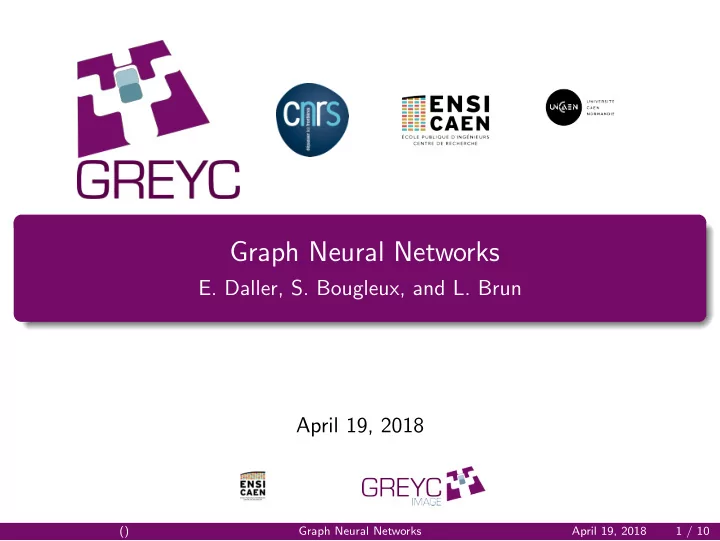

Graph Neural Networks E. Daller, S. Bougleux, and L. Brun April 19, 2018 () Graph Neural Networks April 19, 2018 1 / 10
Different Levels/Steps of Recognition Level 0: Hand made classification (Expert Systems) If x > 0 . 3 and y < 1 . 5 then CANCEROUS Level 1: Design of feature vectors/(di)similarity measures. Automatic Classification Level 2: Automatic design of pertinent features / metric from huge amount of examples. Chemoinformatic is mainly at level 1, Image / Computer vision at level 2. () Graph Neural Networks April 19, 2018 2 / 10
Graph Neural Network OH H O CH 3 H O Graph Projection+PCA on vertices’ features y 1 . . . y 2 GConv Coarsen histogram y 3 + Pool layer Input Graph Supergraph () Graph Neural Networks April 19, 2018 3 / 10
Input Data A usual encoding associate to an atom C the vector: N O C . . . 0 0 1 . . . q q : NonInformative and sparse vectors not convenient for ② convolutions. First Idea : Adapt the notion of treelets O OH Pattern C –O C =O O– C –O O– C =O O C HO C O O Frequency 2 1 1 2 1 q q Each vertex encodes its local configuration ② q q High dimensional vectors ② We do a PCA. () Graph Neural Networks April 19, 2018 4 / 10
Input Graphs Some Graph Neural Networks learn weight without taking account the structure of the graph. Some others take the structure of the graph into account but are limited to fixed graph structures. How to remove this limitation ? We compute a super-graph by using the GED. () Graph Neural Networks April 19, 2018 5 / 10
Computation of the super-graph Given a trainning set { g 1 , . . . , g n } we compute a set of pairs (a maximal matching) minimizing: M ⋆ = arg min � d ( g i , g j ) M ( g i , g j ) ∈ M We then compute the super graph of each pair and so on up to the appex: SG ( . . . ) SG ( . . . ) SG ( g 1 , g 2 ) SG ( g 3 , g 4 ) SG ( g 5 , g 6 ) g 1 g 2 g 3 g 4 g 5 g 6 () Graph Neural Networks April 19, 2018 6 / 10
Processing of input Graphs using the Super-Graph Each graph of the trainning set is a subgraph of the super-graph. It may be considered as one (or several) signal(s) on the super-graph. OH H O CH 3 H O Graph Projection+PCA on vertices’ features Input Graph Supergraph () Graph Neural Networks April 19, 2018 7 / 10
Last layer of a Graph convolutional network The final classification / regression stage requires a layer with a fixed geometry. Pb: Graphs does not have a fixed geometry (unless we use the super-graph) Usual solution : a GAP (Global average pooling). If vertices’ features have dimension D it creates a vector H where: 1 � ∀ c ∈ { 1 , . . . , D } H ( i ) = h c ( v ) | V | v ∈ V where h ( v ) is the feature vector of v ∈ V . q q Very rough estimate. ② We propose to compute instead a D × K pseudo-histogram where K is the number of bins per component. The height of a bin k of this pseudo-histogram is computed as follows: − ( hc ( v ) − µ ck )2 1 σ 2 � b ck ( h ) = e (1) ck | V | v ∈ V () Graph Neural Networks April 19, 2018 8 / 10
Experiments: The Datasets Datasets NCI1 MUTAG ENZYMES PTC PAH #graphs 4110 188 600 344 94 mean | V | , mean | E | (29.9, 32.3) (17.9, 19.8) (32.6, 62.1) (14.3, 14.7) (20.7, 24,4) #labels, #patterns (37, 424) (7, 84) (3, 240) (19, 269) (1, 4) #classes 2 2 6 2 2 #pos., #neg. (2057, 2053) (125, 63) – (152, 192) (59, 35) Results : GConv feat. s-g gpool NCI1 MUTAG ENZYMES PTC PAH – – GAP 62.61 66.98 18.10 56.60 57.18 – GAP 67.81 81.74 31.25 59.04 54.70 ⋆ DCNN – hist 71.47 82.22 38.55 60.43 66.90 ⋆ hist 83.57 71.35 ⋆ ⋆ – – GAP 55.44 70.79 16.60 52.17 63.12 – GAP 66.39 82.22 32.36 58.43 57.80 ⋆ GCN – hist 74.76 82.86 37.90 62.78 72.80 ⋆ hist 80.44 61.60 71.50 ⋆ ⋆ CGCNN – ⋆ ⋆ () Graph Neural Networks April 19, 2018 9 / 10
Conclusion and future Works Our improvment of the first and last layers seems effective. We should investigate why GCN does not like the super-graph. Next Steps: Replace the PCA in order to take into account the objective function. Define a better convolution Define a better coarsening. () Graph Neural Networks April 19, 2018 10 / 10
Recommend
More recommend